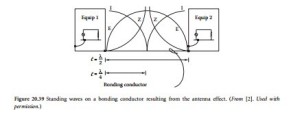Patch-Bay Grounding
Patch panels for audio, video, and data circuits require careful attention to planning to avoid built-in grounding problems. Because patch panels are designed to tie together separate pieces of equipment, often from remote areas of a facility, the opportunity exists for ground loops. The first rule of patch-bay design is to never use a patch bay to switch low-level (microphone) signals. If mic sources must be patched from one location to another, install a bank of mic-to-line amplifiers to raise the signal levels to
dBm before connection to the patch bay. Most video output levels are 1 V P-P, giving them a measure of noise immunity. Data levels are typically 5 V. Although these line-level signals are significantly above the noise floor, capacitive loading and series resistance in long cables can reduce voltage levels to a point that noise becomes a problem.
Newer-design patch panels permit switching of ground connections along with signal lines. Figure 20.40 illustrates the preferred method of connecting an audio patch panel into a system. Note that the source and destination jacks are normalled to establish ground signal continuity. When another signal is plugged into the destination jack, the ground from the new source is carried to the line input of the desti- nation jack. With such an approach, jack cords that provide continuity between sleeve (ground) points are required.
If only older-style, conventional jacks are available, use the approach shown in Figure 20.41. This configuration will prevent ground loops, but because destination shields are not carried back to the source when normalling, noise will be higher. Bus all destination jack sleeves together, and connect to the local (rack) ground. The wiring methods shown in Figure 20.40 and Figure 20.41 assume balanced input and output lines with all shields terminated at the load (input) end of the equipment.

